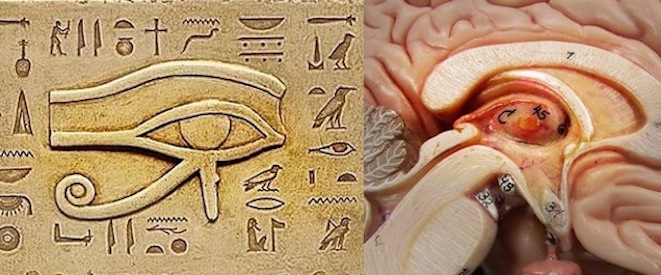The pineal gland (or pineal body) is a tiny pine cone shaped structure seated at the center of the brain. Spiritually, it has been referred to as the Third Eye. Physically, it is responsible for producing melatonin, which affects sleeping and waking patterns, and seasonal changes in the body.
Melatonin is a simple hormone that communicates information about the environment, such as amount of light, to different parts of the body. This seemingly basic response ultimately is responsible for biological rhythms and affects reproductive cycles in many animals.
These days the pineal body has gained some notoriety among mystics as being the seat of the soul or consciousness. In addition to melatonin, the small gland produces DMT, a psychoactive released during life-changing states such as birth and death. The near death experience is sometimes scientifically explained as this DMT release. In addition, the structure may be the mechanism by which we experience out of body experiences that are becoming increasingly common.

This brain structure has a place in history as well. It has a place in the Sumerian and Babylonian mythos, the ancient Egyptians in the staff of Osiris and sculptures in the tomb of King Tut, kundalini serpents in yogic tradition, and hindu symbolism. Even the Christian spiritual tradition recognizes this symbol as a sculpture in Vatican Square.

“The light of the body is the eye: if therefore your eye be single, your whole body shall be full of light” – Matthew 6:22
There is much to be said about the effects of flouride on the pineal gland. The structure tends to attract and store more flouride than other soft tissues in the body, and this is important because high levels of flouride can inhibit enzyme production. The pineal body also contains hard crystallized tissue, which accumulates more flouride than teeth and bones.
We find references to the Pineal Gland in numerous ancient cultures in the form of a pine cone, a third eye representation and more.

We think this subject is fascinating. What do you know about this amazing organ?

